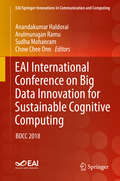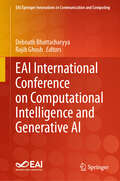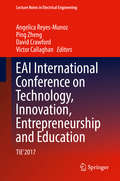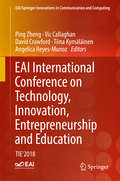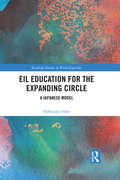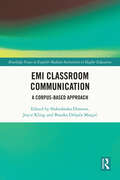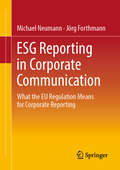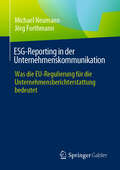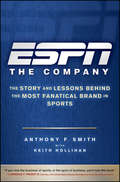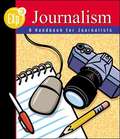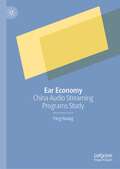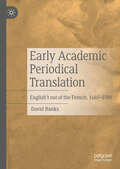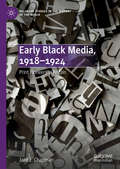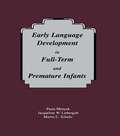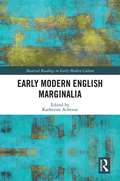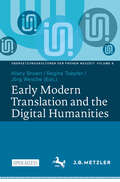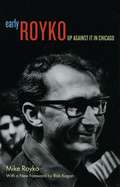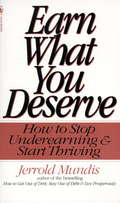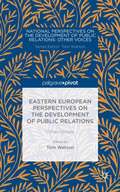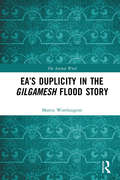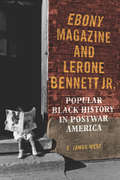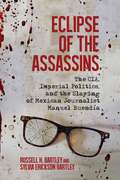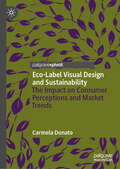- Table View
- List View
EAI International Conference on Big Data Innovation for Sustainable Cognitive Computing: BDCC 2018 (EAI/Springer Innovations in Communication and Computing)
by Chow Chee Onn Anandakumar Haldorai Arulmurugan Ramu Sudha MohanramThis proceeding features papers discussing big data innovation for sustainable cognitive computing. The papers feature detail on cognitive computing and its self-learning systems that use data mining, pattern recognition and natural language processing (NLP) to mirror the way the human brain works. This international conference focuses on cognitive computing technologies, from knowledge representation techniques and natural language processing algorithms to dynamic learning approaches. Topics covered include Data Science for Cognitive Analysis, Real-Time Ubiquitous Data Science, Platform for Privacy Preserving Data Science, and Internet-Based Cognitive Platform. The EAI International Conference on Big Data Innovation for Sustainable Cognitive Computing (BDCC 2018), took place on 13 – 15 December 2018 in Coimbatore, India.
EAI International Conference on Computational Intelligence and Generative AI (EAI/Springer Innovations in Communication and Computing)
by Debnath Bhattacharyya Rajib GhoshThe book presents the proceedings of the EAI International Conference on Computational Intelligence and Generative AI (ICCIGAI 2024), which took place March 8-9, 2024, in Guntur, India. The book explores the exciting and rapidly evolving field of artificial intelligence, with a specific focus on computational intelligence and generative models. The conference introduces cutting-edge techniques and methodologies that enable machines to simulate human-like intelligence and creativity. Readers can find a comprehensive overview of state-of-the-art AI methods, including neural networks, evolutionary algorithms, deep learning, and generative adversarial networks (GANs). The conference explores real-world applications in a range of areas, including computer vision, natural language processing, and the creation of original content.
EAI International Conference on Technology, Innovation, Entrepreneurship and Education: TIE'2017 (Lecture Notes in Electrical Engineering #532)
by David Crawford Victor Callaghan Angelica Reyes-Munoz Ping ZhengThis book presents the proceedings of the 1st EAI International Conference on Technology, Innovation, Entrepreneurship and Education (TIE 2017), which took place at Canterbury Christ Church University on September 11-12, 2017. The central theme of the conference is creativity and innovation, especially in relation to technology, business, education, social and political needs that make modern society flourish. The proceedings feature papers from a cross-disciplinary audience that explore the process of creativity and innovation. The goal is that the various disciplines can learn from each other and see how they might benefit from the cross-fertilization of practices.
EAI International Conference on Technology, Innovation, Entrepreneurship and Education: TIE'2018 (Lecture Notes in Electrical Engineering #532)
by David Crawford Angelica Reyes-Munoz Ping Zheng Vic Callaghan Tiina KymäläinenThis book presents the proceedings of the 2nd EAI International Conference on Technology, Innovation, Entrepreneurship and Education (TIE' 2018), which took place at Ravensbourne University London, London, UK, on September 4, 2018. The central theme of the conference is emerging technologies in relation to business, education, social and political needs that make modern society flourish. The proceedings feature papers from a cross-disciplinary audience that explore the process of creativity and innovation. The goal is that the various disciplines can learn from each other and see how they might benefit from the cross-fertilization of practices.
EIL Education for the Expanding Circle: A Japanese Model (Routledge Studies in World Englishes)
by Nobuyuki HinoThe teaching of English in the Expanding Circle, traditionally called EFL countries, has long been regarded as having no choice but to follow Inner Circle or Anglo-American norms, both in pedagogy and language models. This situation is in sharp contrast with that of the Outer Circle, or ESL countries, where the WE (World Englishes) paradigm, coupled with post-colonialism, has liberated the users of indigenous Englishes from the norms of Anglophone native speakers. Employing. Japan as a primary sample, this book proposes a new paradigm of EIL (English as an International Language) education, by integrating relevant paradigms such as WE and ELF (English as a Lingua Franca), which enables users of English from the Expanding Circle to represent their own voices in international communication.. Various examples of actual classroom practice in EIL are also presented, bridging the longstanding gap between theory and practice in this field.
EMI Classroom Communication: A Corpus-Based Approach (Routledge Focus on English-Medium Instruction in Higher Education)
by Joyce Kling Slobodanka Dimova Branka Drljača MargićExamining English medium instruction (EMI) through a corpus-based approach, this volume offers a critical inquiry into the use of different linguistic and pedagogical strategies in the EMI classroom. It explores aspects of content lecturers’ language use, pedagogy, and intercultural communicative competence by drawing on the findings obtained from EMI lecture corpus analysis and post-observation interviews with EMI lecturers from five universities in Croatia, Denmark, Italy, the Netherlands, and Spain. The book also offers insights into lecturers’ engagement with students in English, which is their second language, as well as their perception of differences between EMI and first-language-medium instruction (L1MI). Finally, the volume provides readers with corpus-based analysis of teachers’ oral ability profiles, as a basis for the identification of communicational challenges and provision of language support. The book will be of interest to scholars interested in EMI in higher education, and postgraduate students in applied linguistics and TESOL programs. It will also be relevant to teachers who are involved in EMI provision, teacher trainers who design support programs for EMI teachers, and policymakers who establish language-in-education policies for EMI.
ESG Reporting in Corporate Communication: What the EU Regulation Means for Corporate Reporting
by Michael Neumann Jörg ForthmannThis book illustrates the challenges posed by the highly complex ESG regulation to corporate communication—and how they can be overcome. Starting from the year 2024, the requirements for Environmental, Social, and Governance (ESG) reporting will be significantly increased. The Corporate Sustainability Due Diligence Directive (CSDDD or CS3D) of the EU mandates that more companies of all sizes provide detailed explanations about the compatibility of their business models with ESG standards. This new era of corporate reporting must be tackled collaboratively by experts in corporate communication, investor relations, and accounting. The goal is to enhance the persuasiveness, reach, and crisis-resilient narrative of ESG reporting. The authors explain which aspects and perspectives are particularly crucial in this context, and how corporate leaders can continuously reassess and balance their speech and actions.
ESG-Reporting in der Unternehmenskommunikation: Was die EU-Regulierung für die Unternehmensberichterstattung bedeutet
by Michael Neumann Jörg ForthmannDieses Buch zeigt auf, welche Herausforderungen die hochkomplexe ESG-Regulierung an die Kommunikation von Unternehmen stellt – und wie diese gemeistert werden können. Mit Beginn des Jahres 2024 werden die Anforderungen an die Umwelt-, Sozial- und Governance-Berichterstattung deutlich erhöht. Die Corporate Sustainability Due Diligence Directive (CSDDD oder CS3D) der EU verlangt von mehr Unternehmen aller Größen detaillierte Erklärungen zur Vereinbarkeit des Geschäftsmodells mit ESG-Standards.Diese neue Ära der Unternehmensberichterstattung muss von Experten aus der Unternehmenskommunikation, der Kapitalmarktkommunikation und dem Rechnungswesen gemeinsam angegangen werden, um die Überzeugungskraft, die Reichweite und das krisenfeste Narrativ der ESG-Berichterstattung zu stärken. Die Autoren erläutern, welche Aspekte und Perspektiven hierbei besonders entscheidend sind und wie Unternehmensverantwortliche ihr Reden und Handeln immer wieder neu gewichten und austarieren können.
ESPN The Company
by Keith Hollihan Anthony F. SmithA fascinating look at ESPN and its success as a brandESPN The Company reveals the inside scoop on the biggest business story in sports, detailing the creative and innovative spirit and practices that drove the programming, products, and services of the most powerful and prominent name in sports media. The authors provide a behind-the-scenes perspective on how ESPN dealt with their many partners and how they handled mistakes and missteps along the way-from the humble beginnings of ESPN as an underrated startup to the pinnacle of their success as a major industry player.ESPN and other great organizations invest in their people. They train them. They believe that if you spend the time and resources turning talented performers into leaders, you're going to get better organizational performance and engender higher levels of commitment and sweat. ESPN The CompanyExplores the dedication to excellence that makes ESPN the "Worldwide Leader in Sports" Reveals how the steps ESPN has taken to excel can be applied to whatever type of business you're inShares the lessons learned at ESPN about launching and growing a wildly successful enterpriseEngaging and informative, this entertaining guide reveals how any company can benefit by embracing the best practices of ESPN.
EXp3 Journalism: A Handbook for Journalists
by Mark Levin"EXp3 Journalism" is an ideal journalism program for middle school students. The book concentrates on newspaper journalism using concepts and skills that are applicable to all areas of journalism. This program uses activities, highly readable text, extensive art, and practical exercises to encourage an enlightening learning experience.
Ear Economy: China Audio Streaming Programs Study
by Ying HuangThis book sheds light on the overall description and explanation of the current socio-political, economic and cultural environment concerning the development of China's audio streaming programs industry. It interprets the emergence of the “ear economy” through the subjects of media ecology, media psychology, communication studies and cultural criticism, media industrial studies, sociology and anthropology. The book skillfully weaves together historical, cultural, and industry studies, along with textual and critical discourse analysis. This interdisciplinary work contributes to multiple academic fields including literary and cultural studies, media and communication studies, China/Asia studies, and political theory.
Earlier (Semiotext(e) / Native Agents)
by Sasha Frere-JonesSasha Frere-Jones&’s evolution as a writer and musician with the deceptively casual intelligence that marks all of his work.Shuttling between his first year of life (1967) and the year he wrote the book (2020), Earlier is a glorious sequence of moments, a record of the experiences that set the shape of a life. Frere-Jones&’s prose floats between clinically precise fragments and emotional impressions of revelations, pleasures, and accidents. It&’s a book about how lives happen and sensibilities form.As fellow music critic Alex Ross observes, &“It is weird to write a book about yourself, as this book is well aware. Gazing in the mirror is not mass entertainment. Sasha Frere-Jones, a writer of nonchalant, rope-a-dope power, drops the illusion of self-knowledge and instead offers up a kaleidoscope of memory shards, faithful to the chaos of inner and outer worlds. Earlier is funny, cool, raw, wise, and secretly sublime.&”Begun in 2010, Earlier was completed at the request of Deborah Holmes, to whom the book is dedicated. Holmes is the mother of Frere-Jones&’s two boys, Sam and Jonah. Diagnosed with pancreatic cancer in July of 2020, Holmes died in January of 2021. Earlier is the last book she read. Frere-Jones says, &“Deborah was the most enthusiastic reader I&’ve ever met. She read when she wasn&’t doing something else, and that never changed. She asked me to write this when we met, in 1990. I am sorry I made her wait so long.&”
Early Academic Periodical Translation: English't out of the French, 1665-1700
by David BanksThis book looks at the translations which appeared in the Philosophical Transactions and whose source texts had appeared in the Journal des Sçavans during the period 1665 to 1700. The theoretical background of the study is Systemic Functional Linguistics. The book provides linguistic analyses of both translations and source texts, considering in particular process types, the nature of themes, modality and nominalization of processes. The periods looked at are defined in terms of the editors of the respective journals. Differences in the linguistic features of the translations and source texts are explained in terms of the historical context. Since these were the first two academic periodicals, the texts studied here were the first attempts at translating academic articles, and thus have particular significance.
Early Black Media, 1918–1924: Print Pioneers in Britain (Palgrave Studies in the History of the Media)
by Jane L. ChapmanThis book represents the first systematic attempt to analyse media and public communications published in Britain by people of African and Afro-Caribbean origin during the aftermaths of war, presenting an in-depth study of print publications for the period 1919-1924. This was a period of post-conflict readjustment that experienced a transnational surge in special interest newspapers and periodicals, including visual discourse. This study provides evidence that the aftermath of war needs to be given more attention as a distinctly defined period of post-conflict adjustment in which individual voices should be highlighted. As such it forms part of a continuing imperative to re-discover and recuperate black history, adding to the body of research on the aftermaths of The First World War, black studies, and the origins of diaspora.Jane L. Chapman analyses how the newspapers of black communities act as a record of conflict memory, and specifically how physical and political oppression was understood by members of the African Caribbean community. Pioneering black activist journalism demonstrates opinions on either empowerment or disempowerment, visibility, self-esteem, and economic struggles for survival.
Early Language Development in Full-term and Premature infants
by Paula Menyuk Jacqueline W. Liebergott Martin C. SchultzDesigned to provide practical information to those who are concerned with the development of young children, this book has three goals. First, the authors offer details about patterns of language development over the first three years of life. Although intensive studies have been carried out by examining from one to 20 children in the age range of zero to three years, there has been no longitudinal study of a sample as large as this--53 children--nor have as many measures of language development been obtained from the same children. Examining language development from a broad perspective in this size population allows us to see what generalizations can be made about patterns of language development. This volume's second goal is to examine the impact of such factors as biology, cognition, and communication input--and the interaction of these factors--which traditionally have been held to play an important role in the course of language development. The comparative influence of each--and the interaction of all three--were examined statistically using children's scores on standard language tests at age three. The volume's third goal is to provide information to beginning investigators, early childhood educators, and clinicians that can help them in their practice. This includes information about what appear to be good early predictors of language development at three years; language assessment procedures that can be used with children below age three, how these procedures can be used, what they tell us about the language development of young children; and what warning signs should probably be attended to, and which can most likely be ignored. In addition, suggestions are made about what patterns of communicative interaction during the different periods of development seem to be most successful in terms of language development outcomes at three years, and what overall indications the study offers regarding appropriate intervention.
Early Modern English Marginalia (Material Readings in Early Modern Culture)
by Katherine AchesonMarginalia in early modern and medieval texts – printed, handwrit- ten, drawn, scratched, colored, and pasted in – offer a glimpse of how people, as individuals and in groups, interacted with books and manu- scripts over often lengthy periods of time. <P><P>The chapters in this volume build on earlier scholarship that established marginalia as an intellec- tual method (Grafton and Jardine), as records of reading motivated by cultural, social, theological, and personal inclinations (Brayman [Hackel] and Orgel), and as practices inspired by material affordances particular to the book and the pen (Fleming and Sherman). They further the study of the practices of marginalia as a mode – a set of ways in which material opportunities and practices overlap with intellectual, social, and personal motivations to make meaning in the world. They introduce us to a set of idiosyncratic examples such as the trace marks of objects left in books, deliberately or by accident; cut-and-pasted additions to printed volumes; a marriage depicted through shared book ownership. They reveal to us in case studies the unique value of mar- ginalia as evidence of phenomena as important and diverse as religious change, authorial self-invention, and the history of the literary canon. <P><P>The chapters of this book go beyond the case study, however, and raise broad historical, cultural, and theoretical questions about the strange, marvelous, metamorphic thing we call the book, and the equally mul- tiplicitous, eccentric, and inscrutable beings who accompany them through history: readers and writers.
Early Modern Translation and the Digital Humanities (Übersetzungskulturen der Frühen Neuzeit #8)
by Hilary Brown Regina Toepfer Jörg WescheThis open-access volume explores how digital resources and methods can be usefully employed for research on early modern translation. The volume focuses mainly on digital resources, and features a number of chapters on translation-specific resources written by members of the teams leading the projects. The resources presented here encompass translations into and/or out of Greek, Latin, the European vernaculars, and Jewish languages (Hebrew, Yiddish, Ladino and Judeo-Italian) and different corpora including plays, encyclopedias, and ‘radical’ texts. While the use of digital methods to analyse early modern translations is still in its early stages, the volume also considers how methods such as data visualisation could shed new light on translation phenomena.
Early Royko: Up Against It in Chicago
by Mike RoykoCombining the incisive pen of a newspaperman and the compassionate soul of a poet, Mike Royko became a Chicago institution—in Jimmy Breslin’s words, "the best journalist of his time." Early Royko: Up Against It in Chicago will restore to print the legendary columnist’s earliest writings, which chronicle 1960s Chicago with the moral vision, ironic sense, and razor-sharp voice that would remain Royko’s trademark. This collection of early columns from the Chicago Daily News ranges from witty social commentary to politically astute satire. Some of the pieces are falling-down funny and others are tenderly nostalgic, but all display Royko’s unrivaled skill at using humor to tell truth to power. From machine politicians and gangsters to professional athletes, from well-heeled Chicagoans to down-and-out hoodlums, no one escapes Royko’s penetrating gaze—and resounding judgment. Early Royko features a memorable collection of characters, including such well-known figures as Hugh Hefner, Mayor Richard J. Daley, and Dr. Martin Luther King. But these boldfaced names are juxtaposed with Royko’s beloved lesser knowns from the streets of Chicago: Mrs. Peak, Sylvester "Two-Gun Pete" Washington, and Fats Boylermaker, who gained fame for leaning against a corner light pole from 2 a.m. Saturday until noon Sunday, when his neighborhood tavern reopened for business. Accompanied by a foreword from Rick Kogan, this new edition will delight Royko’s most ardent fans and capture the hearts of a new generation of readers. As Kogan writes, Early Royko "will remind us how a remarkable relationship began—Chicago and Royko, Royko and Chicago—and how it endures."
Earn What You Deserve
by Jerrold MundisA revolutionary guide to earning power and personal budgeting shows readers how to spend wisely, streamline their finances, and develop a budget that puts their money where they want it to go.From the Paperback edition.
Eastern European Perspectives on the Development of Public Relations: Other Voices
by Tom Watson Lisa G. JohnstonThe National Perspectives on the Development of Public Relations: Other Voices series is the first to offer an authentic world-wide view of the history of public relations. It will feature six books, five of which will cover continental and regional groups. This second book in the series focuses on Eastern Europe.
Eat What You Kill: Becoming a Sales Carnivore
by Sam TaggartFrom the founder and CEO of multimillion dollar sales empire D2D Experts, a battle guide to closing more deals than you ever thought possible.Just ten years ago, Sam Taggart was beating the streets as a door-to-door salesman selling solar and alarm systems, getting thousands of doors slammed in his face – and worse – every day. Now, Sam is the founder and CEO of D2D Experts, a seven-figure sales empire that offers training to an active userbase of 30,000 members. Eat What You Kill is the key to mastering the art of sales - and it all starts with a simple mindset shift.In this practical guide, Sam Taggart teaches readers to be sales carnivores – conquerors with limitless potential – instead of herbivores – victims who make excuses for their failures. No matter what you're selling or how you do it, this book is chock full of winning advice for closing every deal, such as: how to build your own pipeline instead of relying on opportunities from higher-upshow to build a healthy 'sales routine' to maximize earnings and minimize burnouthow to build bullet-proof pitches tailored to the four types of prospecthow to properly frame rejection so you don't lose steamFrom improvisational tips to take your pitches to the next level, to activating your &“prey drive&” to supercharge prospecting, Eat What You Kill is the synthesis of everything Sam Taggart has learned on his way to becoming the world&’s best salesman.
Ea’s Duplicity in the Gilgamesh Flood Story (The Ancient Word)
by Martin WorthingtonThis volume opens up new perspectives on Babylonian and Assyrian literature, through the lens of a pivotal passage in the Gilgamesh Flood story. It shows how, using a nine-line message where not all was as it seemed, the god Ea inveigled humans into building the Ark. The volume argues that Ea used a ‘bitextual’ message: one which can be understood in different ways that sound the same. His message thus emerges as an ambivalent oracle in the tradition of ‘folktale prophecy’. The argument is supported by interlocking investigations of lexicography, divination, diet, figurines, social history, and religion. There are also extended discussions of Babylonian word play and ancient literary interpretation. Besides arguing for Ea’s duplicity, the book explores its implications – for narrative sophistication in Gilgamesh, for audiences and performance of the poem, and for the relation of the Gilgamesh Flood story to the versions in Atra-hasīs, the Hellenistic historian Berossos, and the Biblical Book of Genesis. Ea’s Duplicity in the Gilgamesh Flood Story will interest Assyriologists, Hebrew Bible scholars and Classicists, but also students and researchers in all areas concerned with Gilgamesh, word-play, oracles, and traditions about the Flood.
Ebony Magazine and Lerone Bennett Jr.: Popular Black History in Postwar America
by E. James WestFrom its launch in 1945, Ebony magazine was politically and socially influential. However, the magazine also played an important role in educating millions of African Americans about their past. Guided by the pen of Lerone Bennett Jr., the magazine’s senior editor and in-house historian, Ebony became a key voice in the popular black history revival that flourished after World War II. Its content helped push representations of the African American past from the margins to the center of the nation’s cultural and political imagination. E. James West's fresh and fascinating exploration of Ebony’s political, social, and historical content illuminates the intellectual role of the iconic magazine and its contribution to African American scholarship. He also uncovers a paradox. Though Ebony provided Bennett with space to promote a militant reading of black history and protest, the magazine’s status as a consumer publication helped to mediate its representation of African American identity in both past and present. Mixing biography, cultural history, and popular memory, West restores Ebony and Bennett to their rightful place in African American intellectual, commercial, and political history.
Eclipse of the Assassins
by Russell H. Bartley Sylvia Erickson BartleyThis is a stellar, courageous work of investigative journalism and historical scholarship--grippingly told, meticulously documented, and doggedly pursued over thirty years. Tracking a Cold War confrontation that has compromised the national interests of both Mexico and the United States, Eclipse of the Assassins exposes deadly connections among historical events usually remembered as isolated episodes. Authors Russell and Sylvia Bartley shed new light on the U.S.-instigated "dirty wars" that ravaged all of Latin America in the 1960s, '70s, and '80s and reveal--for the first time--how Mexican officials colluded with Washington in its proxy contra war against the Sandinista government of Nicaragua. They draw together the strands of a clandestine web linking: the assassination of prominent Mexican journalist Manuel Buendía the torture and murder of U.S. Drug Enforcement Administration agent Enrique Camarena the Iran-Contra scandal a major DEA sting against key CIA-linked Bolivian, Panamanian, and Mexican drug traffickers CIA-orchestrated suppression of investigative journalists criminal collusion of successive U.S. and Mexican administrations that has resulted in the unprecedented power of drug kingpins like "El Chapo" Guzmán. Eclipse of the Assassins places a major political crime--the murder of Buendía--in its full historical perspective and shows how the dirty wars of the past are still claiming victims today.
Eco-Label Visual Design and Sustainability: The Impact on Consumer Perceptions and Market Trends
by Carmela DonatoThis book delves into the critical role of eco-labels as signals in a marketplace increasingly driven by consumer demand for sustainable products. It begins with an exploration of how eco-labels function within a tripartite system involving consumers, producers, and third-party certifiers, highlighting the challenges and opportunities in their creation, promotion, and validation. Building on this foundation, the book examines the influence of visual aesthetics on consumer perceptions, drawing from aesthetic psychology and marketing literature to explore how design elements—such as visual and conceptual complexity, color, and text—affect consumer attitudes and trust. The empirical core of the book evaluates real-world eco-labels, analyzing how their visual design impacts sustainability perceptions and label adoption. By synthesizing theoretical insights and empirical findings, the book offers practical recommendations for marketers, designers, and policymakers, aiming to improve eco-label effectiveness in fostering sustainable consumer behavior.
